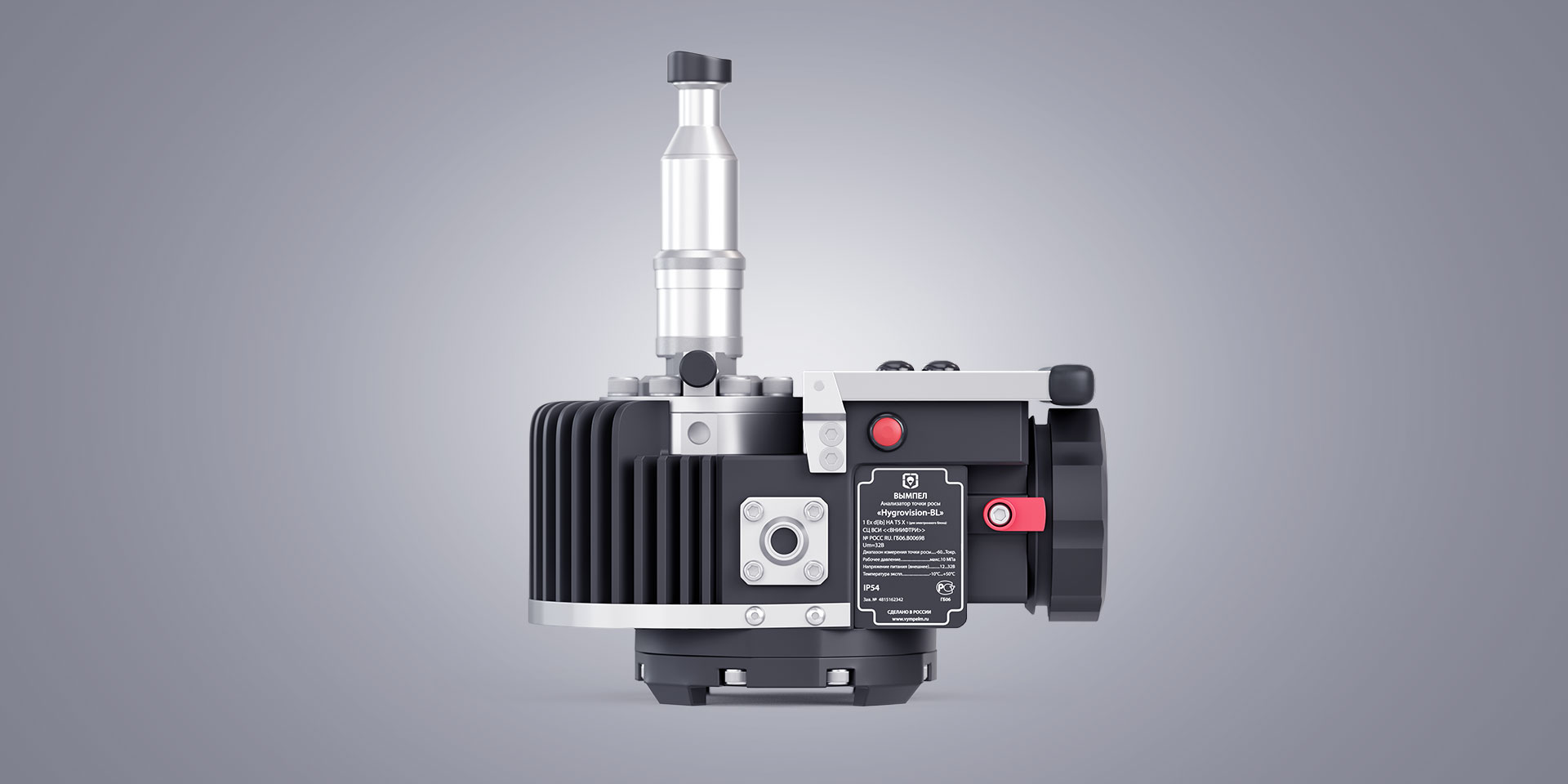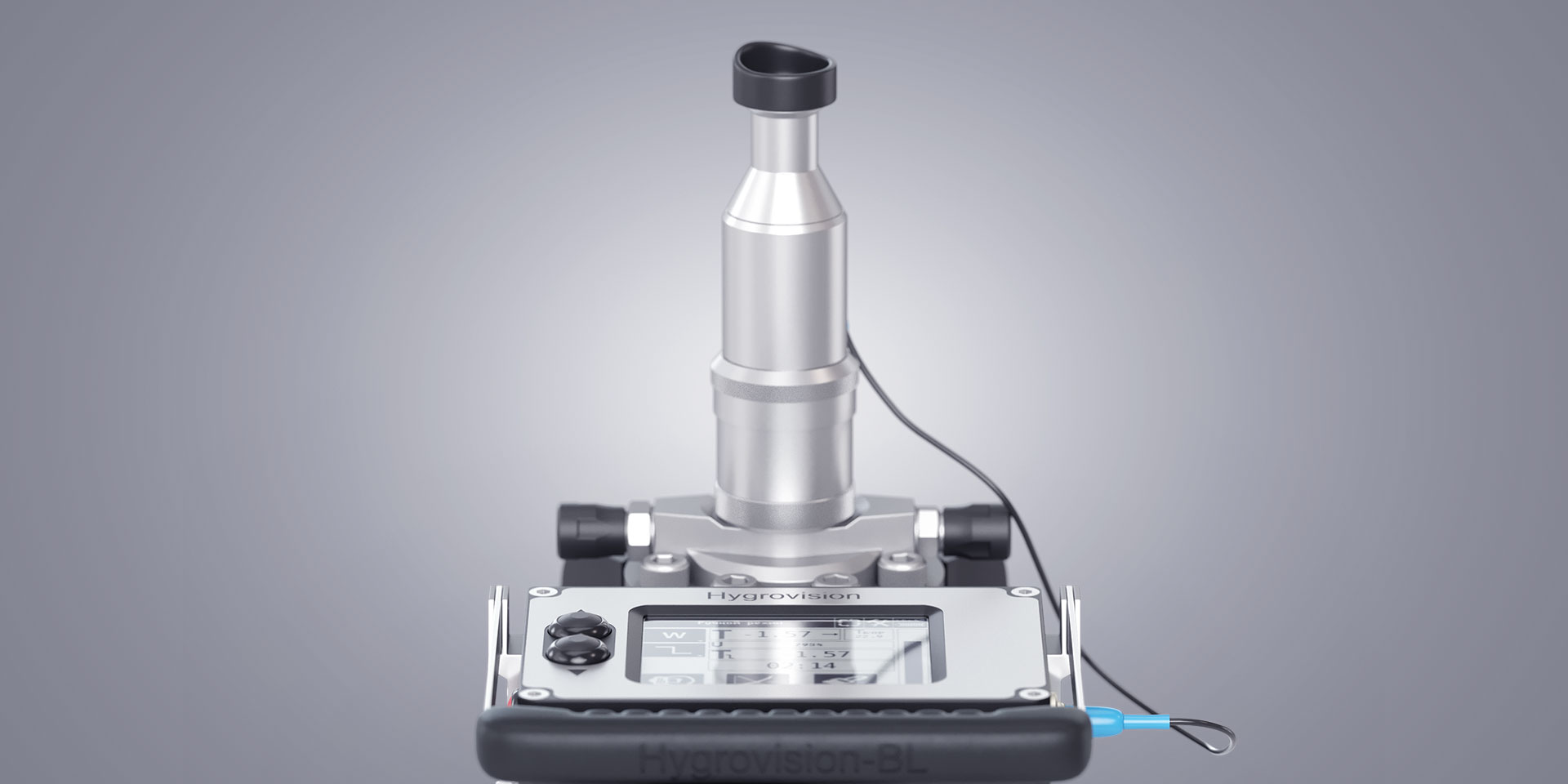The HYGROVISION-BL
dew point analyzer
Fields of application
- gas
- oil
- chemical
- power
- metallurgical industry
- environment protection
- metrology
Intended use
for automated water dew point and hydrocarbon condensation temperature measurements at gas metering stations, underground storage and dehydration units, etc.;to check the efficiency of permanently fixed hygrometers using either manual or automatic mode as well as in combined operation with the "Model-003" gas purification system;
as a comparator hygrometer for the transference of the dew point value between wet gas generators of different precision classes;
for visual monitoring of water and hydrocarbon condensation processes.
Signature
features






- Touch screen display for manual operation;
- Can be used as a comparator unit;
- Can be installed on a standard tripod (i.e. for a camera). The device can also be set up on any stable flat surface.
Characteristics
from -50°C to ambient temperature
Registration principles:
The principle upon which registration of water and hydrocarbon condensation on the chilled mirror’s surface is based involves exploiting the effect of total refraction.
Total refraction is the effect that occurs when light waves that are polarized in the longitudinal plane encounter the interface between dissimilar media in such a manner that the result is the absence of a reflected wave. This effect is only possible when these waves encounter the interface at Brewster’s angle.
In order to achieve this effect, a vertically polarized laser is used as a light source and the mirror is made using a dielectric material.
When the mirror is clean, the laser beam falls on the mirror’s surface at Brewster’s angle and is fully refracted. As a result, a zero signal is obtained at the photodetector output.
Every condensation process on the mirror's surface may be observed using the 40x magnification optical system. This system includes a white LED providing the vertical lighting of the cooling mirror's surface through the microscope’s objective. Side lighting is provided by the laser.
Hydrocarbon condensate registration characteristics
When a thin hydrocarbon film with a different refraction index forms on the mirror’s surface, the conditions for total refraction are not met and a new wave reflected from the gas-film media boundary is formed. Moreover, due to the optical transparency of the condensate film, another wave reflected from the film-mirror media boundary is formed as well. As a result, the photodetector captures two reflected beams which then combine to form an interference pattern.
The hydrocarbon dew point measurement occurs when the thickness of the film is about 5 - 10 nm.
Hydrocarbon condensation can only be observed through the microscope when the vertical lighting of the mirror's surface is on.
Water condensation registration characteristics
When the mirror cools and water droplets condense onto the mirror’s surface, intense scattering of light occurs. Condensation of water vapor onto the mirror results in an increase in the photoelectric signal of the registration system. The signal level from the photodetector depends on the amount of water condensed on the mirror’s surface. The observation of water condensation is possible not only under the vertical lighting of the mirror’s surface, but under the side lighting as well

Questionnaire
Configuration*
Operating manuals
Certificates
- Certificate of approval of measuring device type in Russian Federation
- Measuring equipment type specification
- Certificate of conformance with Technical Regulations of the Customs Union TR TS 012/2011 «On safety of equipment designed for work in explosion hazardous area»
- Certificate of approval of measuring device type in Republic of Belarus
- Certificate of recognition of approval of measuring device type in Republic of Azerbaijan (RU)
- Certificate of recognition of approval of measuring device type in Republic of Azerbaijan (AZ)
- Certificate of recognition of approval of measuring device type in Republic of Kazakhstan (RU)
- Certificate of recognition of approval of measuring device type in Republic of Kazakhstan (KZ)
- Certificate of recognition of approval of measuring device type in Republic of Kyrgyzstan (RU)
- Certificate of recognition of approval of measuring device type in Republic of Kyrgyzstan (KGS)
- Certificate of recognition of approval of measuring device type in Republic of Tajikistan (TJ)
- Certificate of recognition of approval of measuring device type in Republic of Tajikistan (RU)
- Certificate of recognition of approval of measuring device type in Turkmenistan (RU)
- Certificate of recognition of approval of measuring device type in Turkmenistan (TM)
- Certificate of recognition of the approved measuring device type in Republic of Uzbekistan (RU)
- Certificate of recognition of the approved measuring device type in Republic of Uzbekistan (UZ)
Hygrovision-BL – уникальный гигрометр с функциями автоматического потокового и ручного визуального анализаторов
Конденсационный гигрометр точки росы HYGROVISION-BL вобрал в себя все лучшие характеристики потокового автоматического анализатора КОНГ-Прима-2М и визуального измерителя точки росы HYGROVISION-MINI. От КОНГ-Прима-2М он получил уникальную систему оптической регистрации, позволяющую идентифицировать конденсат и измерять заданный параметр - точку росы по воде или углеводородам. От ручного визуального влагомера HYGROVISION-MINI прибор перенял инновационный метод визуализации конденсации при 40-кратном увеличении картинки благодаря встроенному микроскопу, а также аккумулятор, рассчитанный на 6-8 часов непрерывной работы. Следует отметить, что наличие последнего делает конденсационный гигрометр HYGROVISION-BL единственным потоковым анализатором с возможностью автономного питания, причем аккумулятор автоматически запускается при отключении внешнего питания, т.е. прибор становится незаменимым при возникновении всевозможных форс-мажорных ситуаций, особенно на тех участках нефтегазового комплекса, где требуется непрерывное измерение влажности газа.
Все вышеперечисленные функции не просто реализованы в приборе, но реализованы на высоком техническом уровне. Например, гигрометр для газов HYGROVISION-BL запоминает результаты измерений, сделанных как в автоматическом, так и в ручном режимах и хранит их в течение 5 лет. Данные последних 12 измерений отображаются на сенсорном дисплее прибора. Для оперативного съёма данных HYGROVISION-BL имеет ИК-порт.
Таким образом, один прибор – промышленный гигрометр HYGROVISION-BL – по сути может выполнять все манипуляции, связанные с процессом измерения влажности газа:
- измерять точку росы газа по углеводородам или же воде с высокой точностью;
- использовать анализатор как автоматический потоковый и осуществлять арбитражный контроль его измерений простым переключением режимов;
- применять прибор как визуальный переносной гигрометр для контроля других автоматических анализаторов.
Для большего удобства работы с прибором специально для HYGROVISION-BL было разработано дополнительное оборудование:
- блок подготовки газа (бпг) MODEL-001 - позволяет использовать анализатор в качестве потокового стационарного, обеспечивая снижение давления пробы газа с рабочего вплоть до атмосферного;
- устройство для охлаждения корпуса – расширяет диапазон измерений до -60 °С.
Принцип действия конденсационного гигрометра HYGROVISION-BL, как и всех анализаторов фирмы «Вымпел», полностью соответствует требованиям ГОСТ 20060-74/20061-84.
Благодаря таким высоким техническим характеристикам анализатор HYGROVISION-BL был выбран стандартом сравнения межгосударственных эталонов влажности газа стран, входящих в COOMET - организацию национальных метрологических институтов стран Центральной и Восточной Европы.

FAS-W Humidity Analyzer






- Touch screen display for manual operation;
- Can be used as a comparator unit;
- Can be installed on a standard tripod (i.e. for a camera). The device can also be set up on any stable flat surface.

